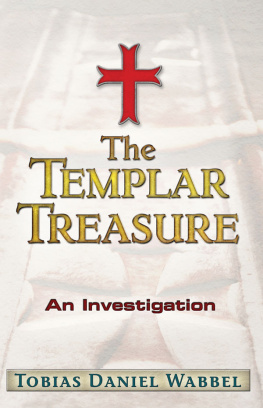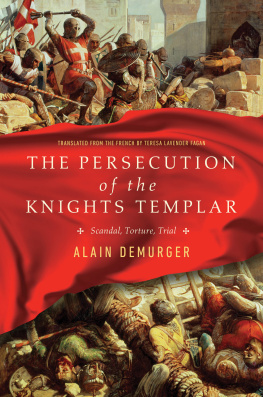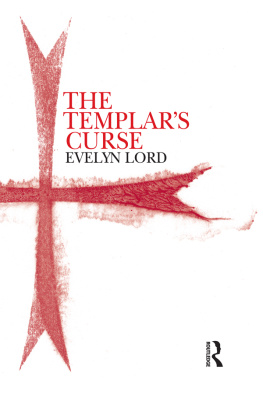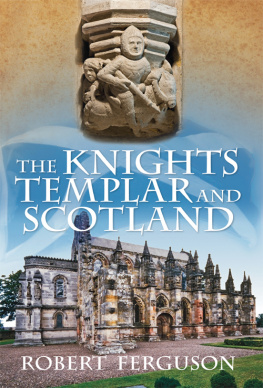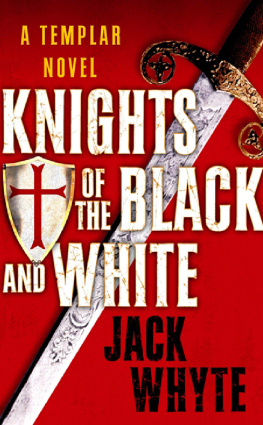Sean Martin - The Knights Templar
Here you can read online Sean Martin - The Knights Templar full text of the book (entire story) in english for free. Download pdf and epub, get meaning, cover and reviews about this ebook. year: 2004, genre: Science. Description of the work, (preface) as well as reviews are available. Best literature library LitArk.com created for fans of good reading and offers a wide selection of genres:
Romance novel
Science fiction
Adventure
Detective
Science
History
Home and family
Prose
Art
Politics
Computer
Non-fiction
Religion
Business
Children
Humor
Choose a favorite category and find really read worthwhile books. Enjoy immersion in the world of imagination, feel the emotions of the characters or learn something new for yourself, make an fascinating discovery.
- Book:The Knights Templar
- Author:
- Genre:
- Year:2004
- ISBN:1-904048-28-5
- Rating:3 / 5
- Favourites:Add to favourites
- Your mark:
- 60
- 1
- 2
- 3
- 4
- 5
The Knights Templar: summary, description and annotation
We offer to read an annotation, description, summary or preface (depends on what the author of the book "The Knights Templar" wrote himself). If you haven't found the necessary information about the book — write in the comments, we will try to find it.
The Knights Templar — read online for free the complete book (whole text) full work
Below is the text of the book, divided by pages. System saving the place of the last page read, allows you to conveniently read the book "The Knights Templar" online for free, without having to search again every time where you left off. Put a bookmark, and you can go to the page where you finished reading at any time.
Font size:
Interval:
Bookmark:
version="1.0" encoding="utf-8"?>sci_historySeanMartinThe Knights Templar enensci_historySeanMartinThe Knights Templar
enensci_historySeanMartinThe Knights Templar enenzqhb.ddldrxFB Editor v2.01 April 20091500E544-4CB4-43AB-BD7D-876CFE236FC20.9
enenzqhb.ddldrxFB Editor v2.01 April 20091500E544-4CB4-43AB-BD7D-876CFE236FC20.9
0.9 initial release
The Knights Templar20041-904048-28-5This edition published in March 2004by Pocket EssentialsPO Box 394, Harpenden, Herts, AL5 1JX, UKDistributed in the USA by Trafalgar Square Publishing,PO Box 257, Howe Hill Rd, North Pomfret, Vermont 05053Copyright Sean Martin 2004Editor: Jennifer SteeleThe right of Sean Martin to be identified as the author of this work has been asserted by him in accordance with the Copyright, Designs & Patents Act 1988.All rights reserved. No part of this book may be reproduced, stored in or introduced into a retrieval system, or transmitted, in any form or by any means (electronic, mechanical, photocopying, recording or otherwise) without the written permission of the publishers.Any person who does any unauthorised act in relation to this publication may be liable to criminal prosecution and civil claims for damages. The book is sold subject to the condition that it shall not, by way of trade or otherwise, be lent, re-sold, hired out or otherwise circulated, without the publishers prior consent, in any form or binding or cover other than in which it is published, and without similar conditions, including this condition being imposed on the subsequent publicationA CIP catalogue record for this book is available from the British Library.ISBN 1 904048 28 5Typography by Avocet Typeset, Chilton, Aylesbury, BucksPrinted and bound in Great Britain by CPD Ltd, Ebbw Vale, WalesThe Knights Templar
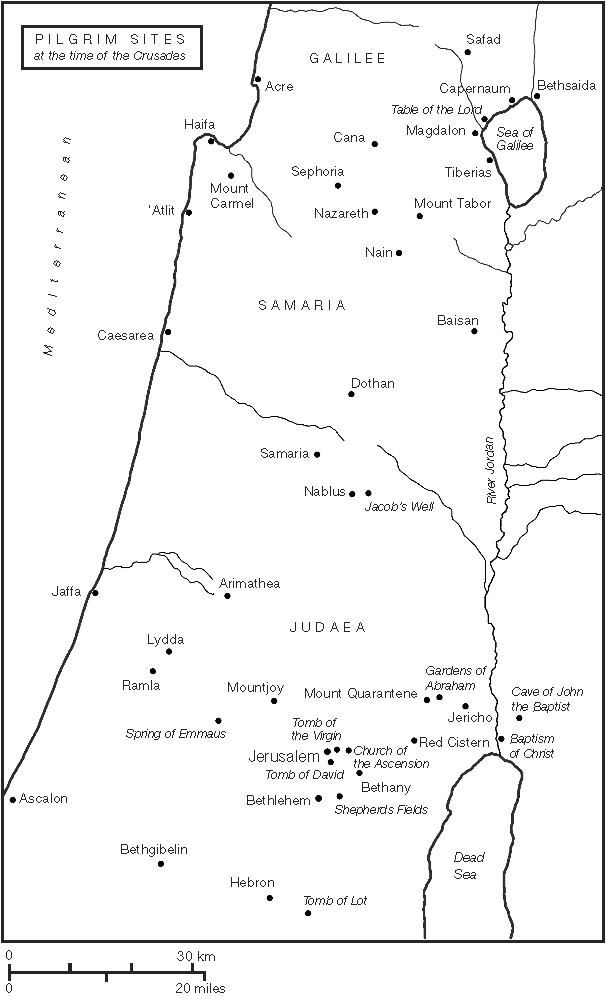
What is history, but a fable agreed upon?
Napoleon Bonaparte
Acknowledgements
Thanks are due to Nicholas Mark Harding, for lending me certain not-so-ancient tomes on this occasion, Mike Paine for the usual moral support, and Richard Leigh, for his advice relating to matters discussed in Chapter 4.
Introduction: The Temple and the Myth
On the morning of 21 January 1793, the French king, Louis XVI, was led out into the Place de la Concord in Paris to face execution. He stepped up onto the platform where the guillotine had been erected, and turned to address the huge crowd who had come to watch him die. He announced that he forgave the revolutionary council who had voted for his death, and then gave himself over to the executioner. The blade fell at 10:15. The executioner held Louis decapitated head up by the hair to show that the king was dead. What happened next, according to some sources, took the crowd by surprise: a man jumped up onto the platform and dipped his fingers in the dead kings blood. He held his hand aloft and shouted Jacques de Molay, thus you are avenged! The crowd cheered, understanding the reference to the last Templar Grand Master, who was burned as a relapsed heretic in 1314; the longheld popular rumour that one day the Templars would have their revenge on the French monarchy which had brought the Order down on dubious charges of heresy, blasphemy and sodomy seemed to have come true. Indeed, speculation was rife that the Templars were among the instigators of the revolution that had swept through France in 1789, ultimately claiming the lives of Louis and his queen, Marie Antoinette.
Modern historians would scoff at such a notion, but it certainly illustrates the unique hold the Knights Templar have had on the European imagination ever since they emerged from obscurity in the late 1120s. They have been seen as heroic soldier-monks guarding pilgrims to the Holy Land during the Crusades, defenders of Holy Church who fought alongside Richard the Lionheart. Their critics in their own time, usually annalists and commentators from rival monastic orders accused them of the sins of pride and arrogance, and were deeply suspicious of the air of secrecy that hung over the Order like a veil. To Walter Scott, they were evil, and he made them the villains of Ivanhoe. Modern historians have tried to show that the Templars were a highly efficient military organisation made up largely of illiterates who were in reality very ordinary; their achievements were to be the creation of the first standing army in Europe since the days of the Roman Empire, and as the first bankers in the West the mediaeval organisation that did most to pave the way for modern capitalism.
Those of a more speculative cast of mind and there have been many over the centuries have seen the Order variously as an esoteric brotherhood, hungry for forbidden knowledge; apostates involved in diabolic practices who were the witches next of kin; a mysterious political entity that has guided world affairs since their suppression, clandestinely directing world events from behind the scenes; and renegade Christians who supported and sheltered heretics, forged links with occult groups in the Arab world and who discovered the Turin Shroud, the Ark of the Covenant and the Holy Grail.
Books about the Templars tend to fall into two camps: what could be termed orthodox and speculative. The former camp is represented by academics such as Malcolm Barber, whose studies The New Knighthood and The Trial of the Templars are critically acclaimed and are the books one should consult if one is seeking a comprehensive treatment of Templar history. The latter camp of speculative writers has spawned a thriving industry of books containing a multitude of theories ranging from the plausible to the risible. In France where there is a vast literature on the Templars the Order holds a position similar to that of Glastonbury in England, a sort of historical tabula rasa onto which almost anything can be projected.
This book will trace the Templar story, from its beginnings in the early twelfth century, through to the suppression of the Order by the Pope in 1312 and the execution of Jacques de Molay two years later. The myths surrounding them will be examined in a later chapter. Whether or not there is any truth to them is, of course, another matter.
The Rise of the Order of the Temple (111945)
The Order of Poor Knights of the Temple of Solomon, more commonly known as the Order of the Temple or The Knights Templar, was founded by the French nobleman Hugues de Payen in around the year 1119 in Jerusalem. The Holy City, back in Christian hands ever since the First Crusade twenty years previously, was the main destination for pilgrims from Europe. They came in their droves, unaware of the dangers that lay ahead the roads around Jerusalem were notorious for the bands of robbers that haunted them, preying on the travellers to the Holy Places. Sometimes these robbers were Saracens; sometimes they were lapsed crusaders. To counter this threat, Hugues de Payen gathered a group of nine knights together to protect the pilgrims.
Hugues and his brothers did not look like the knights of popular imagination. They had no money, wore clothes that were donated to them and suffered from a constant shortage of new recruits and equipment in the early years of their existence. Yet by 1129, at the Council of Troyes, the Templars had become almost overnight the heroes of Christian Europe, and between 1139 and 1145, the Pope issued a series of three papal bulls that gave the Templars almost total power, making them answerable to none save the pontiff himself. It was one of the most remarkable turnarounds of the Middle Ages, if not of all European history.
Next pageFont size:
Interval:
Bookmark:
Similar books «The Knights Templar»
Look at similar books to The Knights Templar. We have selected literature similar in name and meaning in the hope of providing readers with more options to find new, interesting, not yet read works.
Discussion, reviews of the book The Knights Templar and just readers' own opinions. Leave your comments, write what you think about the work, its meaning or the main characters. Specify what exactly you liked and what you didn't like, and why you think so.





